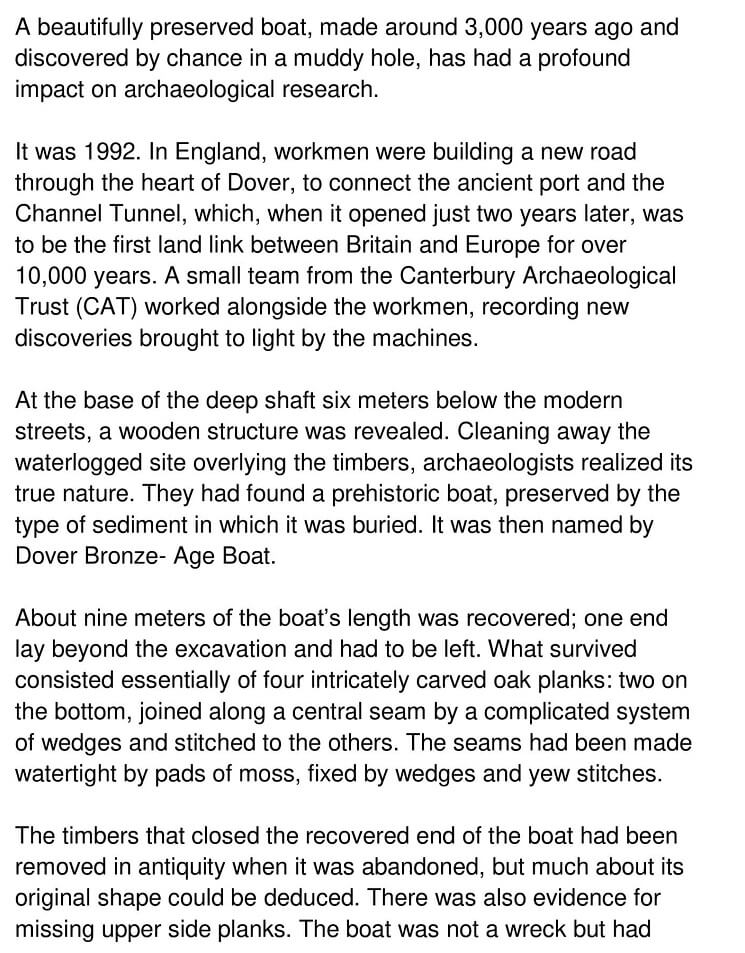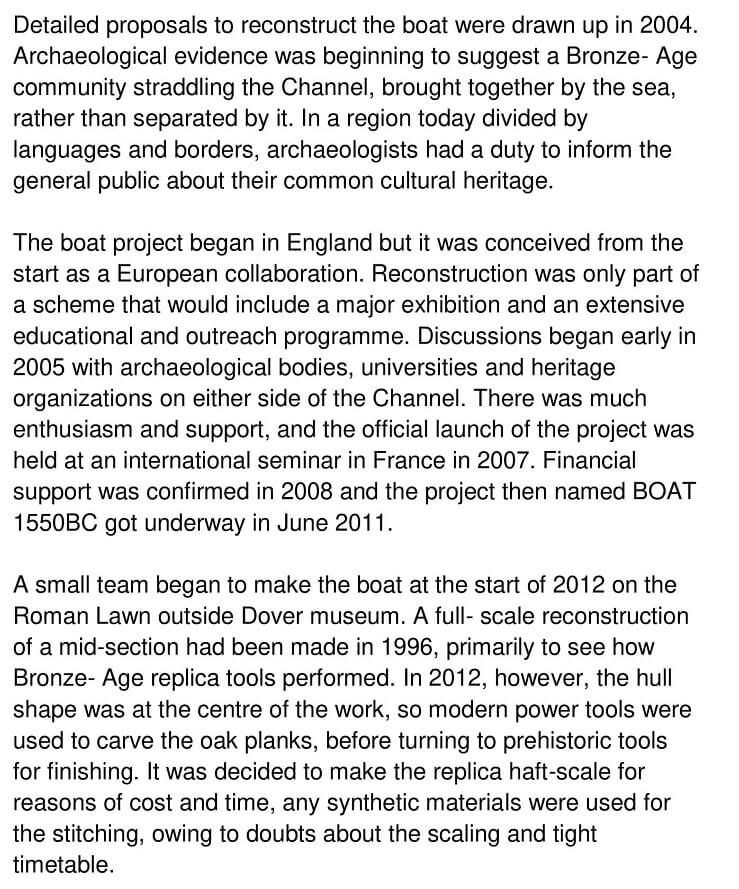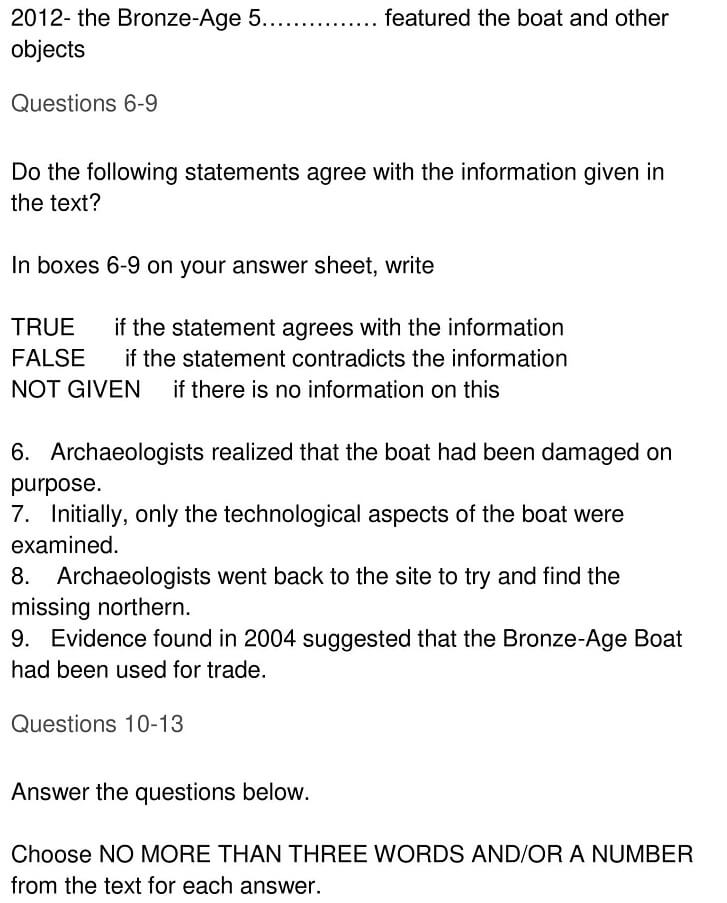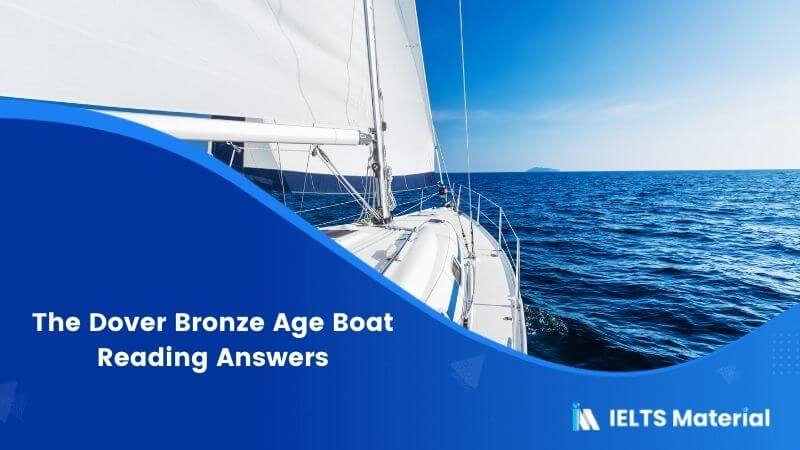The Dover Bronze Age Boat Reading Answers
5 min read
Updated On
-
Copy link
Table of Contents

Limited-Time Offer : Access a FREE 10-Day IELTS Study Plan!
The Academic passage ‘The Dover Bronze Age Boat’ is a reading passage that appeared in an IELTS Test. Try to find the answers to get an idea of the difficulty level of the passages in the actual reading test. If you want more passages to solve, try taking one of our IELTS reading practice tests.
The Dover Bronze Age Boat






Answers
Unlock Answer
Signup/Login and get access to the answers
| Question Number | Answers | Explanation |
|---|---|---|
| 1. | Road | In the beginning of paragraph 2, it is mentioned that in the year, 1992, in England, workmen were ‘building’ (construction) ‘a new road’ through the heart of Dover. In the next paragraph, it is added that, while cleaning away the waterlogged site overlying the timbers, the archaeologists ‘found a prehistoric boat’, preserved by the
type of sediment in which it was buried. Hence, the answer is ‘road’. |
| 2. | Conference | In paragraph 6, it is written that in 2002,
on the tenth anniversary of the discovery, the Dover Bronze Age Boat Trust ‘hosted a conference’, where this meeting of different traditions became apparent. Alongside technical papers ‘about the boat’, other speakers explored its ‘social and economic contexts, and the religious perceptions of boats in Bronze- Age societies’ (information). ‘Many speakers came from overseas’ (international), and debate about cultural connections was renewed. Hence, the answer is ‘conference’. |
| 3. | Proposals | In paragraph 8, it is noted that detailed ‘proposals’ to ‘reconstruct the boat’ were drawn up in ‘2004’. Hence, the answer is ‘proposals’. |
| 4. | Launch | Paragraph 9 points out that there was much enthusiasm and support, and the ‘official launch’ of the project was held at an international seminar in France ‘in 2007’, which was later named ‘BOAT
1550 BC’. Hence, the answer is ‘launch’. |
| 5. | Exhibition | Paragraph 11 mentions that an ‘exhibition’ was being prepared for opening in July,
‘2012’ at the Castle Museum in Boulogne-sur-Mer. It was entitled ‘Beyond the Horizon: Societies of the Channel & North Sea 3,500 years ago’ and it ‘brought together’ (featured) for the first time a ‘remarkable collection of Bronze- Age objects’ (the boat and other objects), including many new discoveries for commercial archaeology and some of the great treasure of the past. Hence, the answer is ‘exhibition’. |
| 6. | True | In paragraph 5, ,it is said that ‘the boat’ was ‘not a wreck’ but had been ‘deliberately discarded, dismantled and broken’ (damaged on purpose). Perhaps it had been “ritually killed” at the end of its life, like other Bronze- Age objects. Hence, the statement agrees with the information and the answer is ‘True’. |
| 7. | False | In paragraph 6, it is given that it was significant that ‘the boat’ was found and ‘studied by mainstream archaeologists’ who naturally ‘focused on its cultural context’. At the time, ‘ancient boats’ were often ‘considered only from a narrower technological perspective’, but news about the Dover boat reached a broad audience. So, it is said that for this particular Dover boat, the archaeologists checked the cultural context while they had checked the technological aspects for the other ancient boats. As the statement contradicts the information in the passage, the answer is ‘False’. |
| 8. | False | In paragraph 7, it is informed that the possibility of returning to Dover to search for a boat’s unexcavated northern end was explored, but practical and financial difficulties were insurmountable– and there was no guarantee that the timbers had survived the previous decade in the changing environment. So, the possibility of going to the northern side was discussed, but ultimately they did not go due to the practical and financial difficulties. As the statement contradicts the information in the passage, the answer is ‘False’. |
| 9. | Not Given | From paragraph 8, it is found that detailed proposals to reconstruct the boat were drawn up in ‘2004’. There are archaeological evidences that suggested a ‘Bronze- Age
community’ straddling the Channel, ‘brought together by the sea’, rather than separated by it. It can be concluded from this information that trade was done in the Bronze Age across the Channel, but there is no mention of the boat being used for the trade. So, the information is not given in the passage and the answer is ‘NOT GIVEN’. |
| 10. | 6 meters | In paragraph 3, it is told that at the base of the deep shaft ‘six meters below’ the modern streets, a wooden structure was revealed. Cleaning away the
waterlogged site overlying the timbers, archaeologists ‘found a prehistoric boat’, preserved by the type of sediment in which it was buried. Hence, the answer is ‘6 meters’. |
| 11. | (pads of) moss | In paragraph 4, the writer notes that the ‘seams’ had been made ‘watertight’ (prevent water from entering) by ‘pads of moss’ (natural material), fixed by wedges and yew stitches. Hence, the answer is ‘(pads of) moss’. |
| 12. | Hull (shape) | From paragraph 10, it is found out that, in 2012, the ‘hull shape’ was at the ‘centre of the work’ (focus), so modern power tools were used to carve the oak planks, before turning to prehistoric tools for finishing.
Hence, the answer is ‘Hull (shape)’. |
| 13. | Cost and time | In paragraph 10 the decision to make the replica (reconstruction) ‘haft-scale’ for reasons of cost and time (factors), is given. It is given that any synthetic materials were used for the stitching, owing to doubts about the scaling and tight timetable. Hence, the answer is ‘cost and time’. |
Check More IELTS Reading Answers
Also check :
Practice IELTS Reading based on question types

Start Preparing for IELTS: Get Your 10-Day Study Plan Today!
Recent Articles

Nehasri Ravishenbagam

Haniya Yashfeen

Haniya Yashfeen

Haniya Yashfeen




Post your Comments